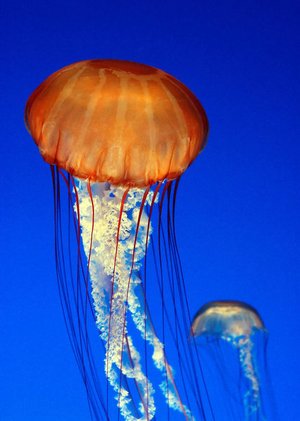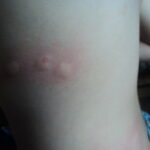The crown jellyfish comes from a family of eight in the taxonomic order Coronatae. These are the Nausithoidae, Tetraplatidae, Paraphylinidae, Atonllidae, Linuchidae, Periphyllidae, Collapididae, and the Atonellidae. Their cone-shaped swimming bell has a reach of 20 cm in height and a diameter of 17 cm. The bell is see-through revealing its reddish brown stomach. The swimming bell is not see-through in larger crown jellyfish, but cloudy with a reddish brown color. There are 16 deep notch lappets as well as tentacles that are on the surface of the bell.
The crown jellyfish can be found deep below the ocean at around 3000 feet or (900 meters). The temperature of the water is very cold there. It has an up and down movement from its deep place during the day to the shallow waters at night, while following and catching prey. Once they are exposed to bright light, they will swim downward. They are found mainly in the Atlantic and Pacific Oceans. They are also highly populated in the New Guenea oceans.
Crown jellyfish are carnivorous creatures. They catch fish, shrimp, and many other animals onto thier tentacles. Their diet also consists of plankton which are about 1/5 in their diameter. These include the diatoms, mollusk larvae, algae, invertebrate eggs, and more. When they feed, they hold their tentacles on the upside of the bell swimming in a downward motion about 10m and then drift back upward. During that time their tentacles are moved quickly towards their mouth coiling and enter the stomach. They paralyze the prey with the stinging cells on their tentacles before entering the mouth.
Crown jellyfish reproduce by releasing the fertilized eggs into deep water where they can drift for many months. The eggs and larvae can be seen all year round in Lurefjorden, Norway. This shows that there is no seasons in the oceans constant environment. There is no polyp or ephyra stages in the larvae’s medusae development. Planula, a larval form, develops from the egg after it has been fertilized and starts to grow.
The planula is covered with cilia and it plants itself firmly onto a surface that allows it to develop into a polyp. It, then, will resemble a small sea anemone with tentacles that is cup-shaped surrounding a single orifice. The poly will soon reproduce asexually once it begins budding. Many of these crown jellyfish will have a lifespan of up to two and a half months. Some live longer than six months.
Breeding season is in the summer when the sexes will separate and release small planula larvae, settling and developing into colonies of polyps. Each of these polyps will bud off and develop into a jellyfish. The bodies of the crown jellyfish are 95-99 percent water-based jelly containing less than 5 percent organic matter. Their stingers will spit out venomous thread when touched. The most venomous jellyfish is from Cubomedusae family which is named for their square-like shape.
source: Creation Wiki. Crown Jellyfish. http://creationwiki.org/Crown_jellyfish





